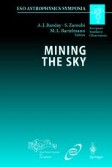Search
Search Results
-
Blind Source Separation of Multispectral Astronomical Images
Multispectral images lead to classify pixels, but often with the drawback that each pixel value is the result of a combination of different sources....
-
Extracting Knowledge from Very Large Datasets in a Multi-Wavelength Context
The ability to extract knowledge from very large data catalogues resulting from sky surveys or from deep wide fields, observed at various wavelength...
-
OPTICON and the Virtual Observatory
The challenges of multi-wavelength astrophysics require new outlooks from those appropriate to traditional astronomy. The next generation of research...
-
Mining the CDS Collection: A Learning Experience
The experiences gained as a result of the CDS/ESO Datamining project are described in this paper as well as a brief outline of the tools developed...
-
DEEP: Pre-DEIMOS Surveys to $I \sim 24$ of Galaxy Evolution and Kinematics
DEEP is a two-phase program designed to undertake spectroscopic surveys of faint field galaxies with the Keck Telescopes. The scientific goals...
-
Constraining Models of Galaxy Formation with Deep Multicolor Galaxy Surveys
We present a comparison between the observed properties of high redshift galaxies, as they result from the analysis of deep multicolor imaging...
-
Modeling Faint Morphological Number Counts
We revisit our recent results concerning comparisons of magnitude and photometric redshift data from the Hubble Deep Fields to statistical...
-
Distant Disk Galaxies: Kinematics and Evolution to $z \sim 1$
High resolution HST images have been combined with Keck+LRIS and VLT+ISAAC spectra to study the internal kinematics of 100 faint disk galaxies in the...
-
Optical and Near-IR Identifications of (Sub)Millimeter Background Sources
We summarise preliminary results of our search for optical and near-infrared counterparts to millimeter continuum background sources discovered in...
-
The Star Formation Density in the High-Redshift Universe
We use images of the Hubble Deep Fields (HDFs) to estimate the universal star formation density (SFD) and its evolution. We find that it increases...
-
Population of Cl1601+42 at z = 0.54
We use photometric redshifts to determine the rest frame cluster luminosity function (LF) to...
-
High-Energy Large-Area Surveys: From BeppaSAX to Chandra and XMM
Optical identification of hard X-ray selected BeppoSAX and Chandra sources indicates that a large fraction of the sources are “intermediate” AGN,...
-
Deep Observations of Lyman Break Galaxies
We summarise the main results of recent work on the Lyman break galaxy population which takes advantage of newly commissioned instrumentation on the...
-
VLT Imaging of Quasar Host Galaxies at $z \sim 1.5$
We present high spatial resolution near-infrared H-band ( $1.65 \mu$...
-
Galaxies Near Distant Damped Ly- $\alpha$ Clouds
We are obtaining deep, broad band images with MOSAIC and IRIM at the KPNO 4-m of 5 QSO fields controlling damped Ly...
-
Deep Surveys with SIRTF’s Infrared Array Camera
The Infrared Array Camera (IRAC) on NASA’s Space Infrared Telescope Facility (SIRTF) will provide imaging at 3.6, 4.6, 5.8 and 8 μm. The four bands...
-
Optical/Infrared Survey of Galaxy Clusters
In this contribution the ongoing effort to build a statistical sample of clusters of galaxies over a wide range of redshifts to study the evolution...
-
The Present: Capodimonte Deep Field. The Future: Science with VST
The VLT Survey Telescope (VST) project is a cooperation between ESO, the Capodimonte Astronomical Observatory (OAC) in Naples, Italy, and the...
-
The BMW Deep X-Ray Cluster Survey
We briely describe the main features and first results of the BMW survey of serendipitous X-ray clusters, based on the still unexploited ROSAT-HRI...
-
XMM-Newton Deep Fields
The XMM-Newton Observatory offers unprecedented effective collecting area in the X-ray energy range 0.1-15keV, and excellent angular resolution. This...
